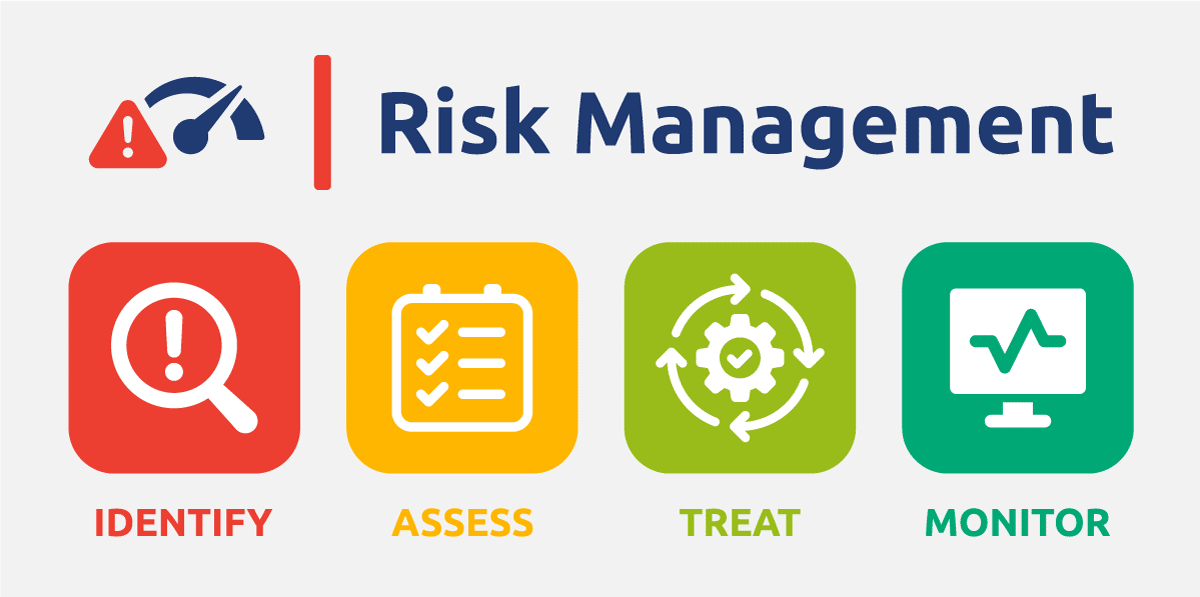An outsourcing strategy is a plan developed by a company to identify which tasks or services it will outsource, and to what extent. The strategy typically involves considering the costs and benefits of outsourcing, as well as the potential risks and opportunities.
Let’s look at what goes into an effective outsourcing, with an emphasis on managing risks to ensure the advantages outweigh the disadvantages.
Outsourcing Strategy Definition

An outsourcing strategy refers to a company’s plan for using external resources, rather than its own employees, to perform certain business functions.
The strategy could include hiring contractors or consulting firms to handle specific tasks, or partnering with other companies to provide goods or services. Outsourcing can be used to reduce costs, improve efficiency, and access specialized expertise.
Most or all the elements of the outsourcing plan need to go right for the exercise to be successful and sustainable. While you do get the chance to learn by experience, getting the core elements of the strategy right in the first place can make or break a business venture.
There are many factors to consider when developing a strategy. Some companies outsource certain tasks because they lack the necessary skills or resources in-house, while others may do so to focus on their core competencies.
The level of risk involved in outsourcing, the potential impact on the company’s culture, and the need for flexibility are all factors that may be taken into account.
Business process outsourcing
Business process outsourcing (BPO) refers to the practice of outsourcing specific business functions or processes to external service providers. These functions or processes may include things like customer service, data entry, payroll, and accounting.
BPO allows a company to focus on its core competencies and outsource non-core activities to specialized service providers.
Regular outsourcing, on the other hand, refers to the practice of hiring external contractors or companies to perform a wide range of tasks or projects. This can include both business functions and processes as well as other types of work. Regular outsourcing can be broad in scope and may not be limited to specific business functions or processes.
Strategic outsourcing
Strategic outsourcing refers to the practice of outsourcing certain business operations in a deliberate and planned manner as part of a company’s overall business strategy.
In contrast to transactional outsourcing, which focuses on individual tasks or projects, strategic outsourcing involves a longer-term, strategic relationship between a company and its external partners.
Managers select and work with external partners to perform tasks or functions that achieve business objectives. Strategic outsourcing requires careful planning and ongoing management to ensure the outsourced activities properly support the company’s objectives.
Types of Strategies
There are four basic types of outsourcing strategies an organization may use.
- Offshore outsourcing: This involves outsourcing tasks or functions to a company located in a different country. This can be done to take advantage of lower labor costs, access to a larger pool of talent, or to tap into new markets.
- Onshore outsourcing: Outsource tasks or functions to a company within the same country. This can be done to maintain control over the outsourced function, or to take advantage of specific local expertise.
- Vertical outsourcing: Outsource a specific function or process that’s up or down the industry supply chain to a firm that specializes in that particular area. For example, a product development company may outsource its manufacturing to a supplier that specializes in this type of work.
- Horizontal outsourcing: This involves outsourcing a function or process that is not directly related to the company’s core business. For example, a building company may outsource its IT support to a specialized IT firm.
Whether you outsource vertically, horizontally or both is really a function of need. The onshore vs offshore decision can be difficult and may depend on factors such as exchange rates and taxes, economic policies in your home country, and relative labor market conditions.
Activities You Can Target

There are many different types of activities that companies may consider for outsourcing. Generally, you’ll try to outsource the things the company is not especially good at. Activities could include:
- Manufacturing: Hire another firm to produce goods or components that are used in the production of your company’s products.
- Logistics: Hire a third-party company to transport, store, and distribute goods.
- Information technology: Engage a company to deliver information technology (IT) services, such as software development, system maintenance, and support.
- Business process outsourcing (BPO): This involves contracting a third-party company to handle non-core business functions, such as customer service, accounting, and HR.
- Knowledge process outsourcing (KPO): In this case, the firm you hire takes care of more specialized or technical tasks, such as research and analysis, data entry, and legal support.
- Project-based outsourcing: This is where you outsource a discrete project or a task on a temporary basis. In other words, the job has defined start and end points.
It’s important for a company to carefully consider which tasks or functions are best suited for outsourcing. You also need to choose an outsourcing partner that has the necessary skills, expertise, and resources to meet business needs.
Advantages

An outsourcing strategy will help you capture the benefits from externalising certain business functions while focusing on your core strengths. Potential advantages include:
- Cost savings: Lower operating costs by taking advantage of lower labor and overhead costs in other countries or by using specialized service providers who can perform the work more efficiently.
- Improved efficiency: Take advantage of the expertise and specialized skills of service providers, which can lead to improved efficiency and productivity.
- Focus on core competencies: By outsourcing non-core functions, a business can free up time and resources to focus on its core competencies and strategic priorities.
- Access to new markets: Enter new markets or expand operations by partnering with service providers who have local market knowledge and resources.
- Flexibility: Outsourcing offers greater flexibility to scale up or down its operations as needed, without the need to invest in additional in-house resources.
To sum up, an effective strategy allows a business to reduce costs, improve efficiency, focus on core competencies, access new markets, and gain flexibility.
Disadvantages

Your outsourcing strategy should factor in the significant potential drawbacks of buying rather than doing certain activities. Potential disadvantages include:
- Loss of control: Outsourcing certain functions or activities obviously means giving up some control over how the work is performed. This can be a concern if the quality of the work is vital or if there is risk that the service provider won’t meet expectations. Outsourcing companies are more concerned about profit than necessarily doing a good job.
- Communication challenges: Working with outsourcing companies in different countries or time zones can be costly by creating communication challenges and potentially causing misunderstandings or delays.
- Cultural differences: Working with service providers from different cultural backgrounds can also create misunderstandings and challenges.
- Dependence on the service provider: Becoming too reliant on a single outsourcing company can create vulnerabilities for the business if the relationship ends or if the service provider experiences problems.
- Legal and regulatory issues: Outsourcing can also involve navigating complex legal and regulatory issues, such as contracts, intellectual property, and data protection.
- Loss of jobs: Outsourcing can also lead to the loss of jobs in the company as functions are transferred to external service providers. This can be a concern for employees and can create morale issues within the company.
To sum up, the strategy must account for potential problems and complications, which can impose significant costs. Drawbacks to outsourcing include loss of control, communication challenges, cultural differences, dependence on the service provider, legal and regulatory issues, and loss of jobs within the company.
Outsourcing vs In-House Team
There are pros and cons to both outsourcing and having an in-house team.
Outsourcing can be a good option if you need specific skills or expertise that you don’t have in-house, or if you want to save on labor costs. It can also be a good way to scale up or down quickly, depending on the needs of your business. However, outsourcing can also be more expensive in the long run, as you may have to pay for the expertise of the outsourced team. It can also be difficult to manage an external team, as there may be language and cultural barriers to overcome.
Your employees can’t be good at everything. You might not have in-house resources that can complete a particular project successfully. Sometimes, it’s not practical to try to take on a project that’s far outside of your team’s expertise.
Boris Mustapic
On the other hand, an in-house team can be more efficient and easier to manage, as the team members are all in the same location and working towards the same goals. It can also be more cost-effective in the long run, as you don’t have to pay for the expertise of an outsourced team. However, in-house can be more expensive upfront, as you have to pay for salaries, benefits, and other overhead costs. It can also be more difficult to scale up or down quickly.
5 Stages of Outsourcing
Outsourcing an be represented as a 5-stage process, with each stage centered around a business question. You should be able to answer “Yes” to each of the following questions for outsourcing to be effective and worth it.
- Is the opportunity appropriate? The outsourcing opportunity should make your firm more competitive in the marketplace rather than dilute uniqueness.
- Is this opportunity real? A business case will need to be developed which confirms quantitatively that genuine benefits will be delivered.
- Can we craft a good deal with a qualified provider? An agreement must be reached with a good service provider that will deliver the kinds of benefits anticipated.
- Can we execute? The hiring firm will need to modify internal processes to integrate outsourcing arrangement beneficially.
- Can we provide ongoing management for this agreement? Once the outsourcing arrangement is in place, you must be able to keep it moving forward and avoid stagnation.
How to Manage Risks

You lose some control over activities relating to your business when you outsource. This may be a good thing depending on company strengths and weaknesses, but also brings risks.
Some of the major risks are: risks to business continuity, privacy risks, non-compliance with laws and regulations, and reputational damage.
Here are strategies to avoid or at least minimize risk. These need to be built into your outsourcing strategic plan.
Due diligence
Conduct thorough due diligence on potential outsourcing partners. This includes researching the company’s track record, financial stability, and any potential legal or compliance issues.
Define contract and service terms well
Use contracts and service level agreements (SLAs) to clearly define the terms of the outsourcing arrangement. This can help to minimize misunderstandings and reduce the risk of disputes. Companies that provide outsourcing services may seek complex, detailed legal arrangements that work in their favour. Legal details need to be checked.
Make communication a priority
Establish clear communication channels. Regular check-ins with the outsourcing partner helps to ensure that everything is running smoothly. Any issues that may arise will be quickly identified.
Contingency planning
Have contingency plans in place. Put a plan in place for what to do if the outsourcing relationship does not work out or if the outsourcing company experiences any issues that impact their ability to provide services.
Review regularly
Regularly review and assess the outsourcing arrangement. Monitor how well your partner is meeting business needs to identify and address any potential risks (or opportunities).
Strategy for a Project

Effective outsourcing of a project doesn’t just happen by chance. Support and leadership is required from the top of the organization. You also need capable people for planning and implementation. Let’s look at how to create a highly successful outsourced project team.
A step-wise approach
It’s possible to effectively outsource certain aspects of a project while still maintaining control over the overall direction and quality of the work. Following these steps.
- Identify the tasks that can be outsourced: Determine which tasks can be completed by an external vendor, rather than in-house staff.
- Research potential vendors: Look for vendors who have relevant experience and a track record of success.
- Negotiate terms: Clearly define the scope of work and agree on a timeline and budget with the vendor.
- Communicate effectively: Establish clear lines of communication and make sure that both parties are on the same page throughout the project.
- Monitor progress: Regularly check in with the vendor to ensure that the work is on track and of high quality.
The outsourcing teams
Most outsourcing projects require a series of teams, which will evolve over the life of the agreement. With each step, different people become engaged.
- Early business planning and evaluation is typically handled by an ideas team.
- As the project moves toward implementation, more operational people usually get drafted in.
- A transition team may be required, followed by an assessment and management team who will analyse and adjust the project long term.
- External advisors and consultants may also be called on as required.
Project leader qualities
As with most business activities, the role of the team leader is critical. What are the characteristics of strong outsourcing project leaders? They need to have:
- the ability to embrace and champion change
- previously earned credibility within the organization
- a desire to manage others, not simply do things
- the ability to build trust in others
- good communication and negotiation skills and aptitudes
- good strategic management skills
- knowledge of how to manage and market new processes
- good process expertise and know-how.

Don’t forget the legal costs from drawing up and enforcing outsourcing contracts. A good legal service or in-house legal team will provide appropriate controls in each contract with overdoing the details and volume.